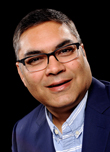No CRO? No Problem As Curadev Tackles Site Selection For Its First Clinical Trial
A conversation with Manish Tandon, COO & CFO, Curadev

You hear it all the time from clinical trial sponsors: Our focus is the patient. The phrase is trite but true. When developing a therapy and designing a trial, the patient must remain at the forefront for both to be successful. But how it gets to the patient is of paramount importance, as we learned from Curadev’s Manish Tandon as the biotech pursues its first-in-human trial of its systemic allosteric STING agonist, CRD3874-SI, for patients with advanced sarcoma and Merkel cell carcinoma.
Curadev, headquartered in India with a wholly owned subsidiary in Boston, recently wrapped up its first treatment cycle for its first patient dosed without adverse events at Memorial Sloan Kettering Cancer Center. It’s not surprising that Curadev would work with Sloan Kettering, given its prominence, but it is interesting to learn how the decision came to be — especially considering Curadev is navigating their trial without the assistance of a CRO.
In this interview, we talked with Tandon about Curadev’s site selection process, covering a site’s influence on patient recruitment and centricity, as well as digging into the advanced planning that allows partnerships like these to form.
Clinical Leader: Curadev recently began its Phase 1 study of its lead STING agonist CRD3874 at Memorial Sloan Kettering, a leading U.S. cancer center. Site selection matters greatly when it comes to executing a successful trial and enrolling a sufficient target patient population. What factors played a role in Curadev's decision to select this healthcare system?
Manish Tandon: Memorial Sloan Kettering is one of the world's premier institutes as far as cancer treatment goes, and they are renowned for conducting many Phase 1 trials. Their paramedical staff, nursing staff, and pharmacists, in addition to their clinicians, forms an ecosystem, which made it a good choice for us to start. We also believe there is a patient population that has a lot of trust in Memorial Sloan Kettering, and the people who go there are informed about the treatment options. They are empowered to choose a better option, a newer treatment.
Do patients see the “Memorial Sloan Kettering” name, understand its reputation, and say, “This is a place I want to go to receive what is considered an experimental treatment”?
Absolutely. That goes for a few other premier institutes around the U.S. as well. These institutes put significant focus on the kind of new technology or treatment that they're getting into the clinic and are offering to the patients. This endorsement is important for the patients, especially the ones who are actively seeking out advanced treatments. It underscores our commitment to catering to informed patients, ensuring they have access to the most promising treatments available.
Before you decided on Sloan Kettering, what were your initial steps in seeking a clinical trial site, and what ultimately kicked off the relationship with Sloan Kettering?
We have a good history in preclinical deals with all the top 10 pharma companies, such as Roche, Takeda, and Bayer. However, as this is Curadev’s first clinical trial, we wanted to partner with one of the premier institutes to not only bolster our credibility but also provide access to a patient population willing to try new treatments.
Over the past two years, we've been actively engaging with two or three institutions as we progressed toward an IND application. Simultaneously, we began conducting animal trials and establishing manufacturing about a hundred miles from Boston. While that was happening, we were having conversations with clinicians across the institutes.
When Sloan Kettering expressed interest in supporting us, it gave us more confidence. Our scientific approach and impressive preclinical data, coupled with a fast IND approval from FDA, further bolstered their conviction, and they were keen to partner with us. As far as study startup and waiting time, they cut down on that. So, all those factors together made us choose Sloan Kettering as a first center.
I think it's a win-win for all three — for Sloan Kettering to get something new, for Curadev if the treatment gets approved, and the biggest beneficiary are the patients, as they get to see something new that can help them, hopefully, wipe out cancer or maybe extend their life in a meaningful way.
This is the first time you've worked with Sloan Kettering. Looking to the future, how important will it be for you to continue that partnership?
Continuing with Sloan Kettering will be a no-brainer because of their exceptional capabilities and alignment with our objectives. However, it's essential to consider that solely relying on one center from Phase 1B/2A onwards may limit the diversity of patient populations we can access. While we remain committed to our partnership with Sloan Kettering, we are actively exploring opportunities to expand our reach. We're currently in discussions with several other hospitals and institutes, with plans to initiate expansion efforts as we progress to Phase 1B/2A.
It sounds like you have been working ahead, almost starting the next step before the current step is even finished. How important is that?
It is very important to build that confidence. Let’s for a minute step back to consider any other business; you're never going to have any business association in just one or two meetings. It takes several meetings, and it takes months. COVID, unfortunately, has extended those timelines. Since things have changed, any business would need to have that confidence and reputation building and understanding of what is right for you. The person or the clinician on the other side should also equally believe in the science that you're proposing. To have that buy-in takes more than a few meetings and a deeper understanding of the science that we're offering.
When you talk about having these meetings ahead of time to establish that trust and confidence, who do you bring to the conversation?
All the senior executives: CEO, CSO, vice president, R&D, and myself. We start the conversation and then we build on that with the broader science team — people who are doing cell biology, people who are doing animal models, people who are doing PK/PD. But largely it's the Curadev executive team that remains actively engaged in driving the discussions forward. Once we start a relationship, for example now with Sloan Kettering, we have a broader group that communicates every two weeks with them to see if there are any gaps that we can identify and address so as not to inconvenience the patient when they are at the hospital to get the treatment.
You've told us who you like to have at the table from your side of things, but who do you like to meet from the site?
Clinicians, primarily, but it's very important to include the pharmacists and the nursing staff, too. This is another reason why it takes a longer time to build that relationship. Once the clinicians understand the science, then it goes to the follow-up steps.
Especially in first-in-human trials, there could be nitty gritty details in the formulation at the pharmacy level or some specific requirement at the nursing level. For example, when we made the pharmacy manual, we had at least five rounds of conversations with the pharmacists, taking their inputs to see what is feasible at their site. That's critical. And then when you are injecting this IV drug, it has to be pumped at a specific rate so it should finish in one hour. So, the administrator of that IV should be trained properly. We tend to meet everyone not only initially, but biweekly, all three groups from their side — the clinician, the pharmacist, and the nursing head.
About The Expert:
 Manish Tandon is a cofounder of Curadev and serves as its chief operations officer and chief financial officer. With three decades of experience in the life sciences industry, Manish has been responsible for various commercial activities, including manufacturing, finance, contracts, intellectual property, and regulatory compliance. He was pivotal in securing transformative out-licensing agreements with Roche, Takeda, and Bayer, driving Curadev's strategic growth. He also spearheaded the company’s expansion into the U.K. and the US.
Manish Tandon is a cofounder of Curadev and serves as its chief operations officer and chief financial officer. With three decades of experience in the life sciences industry, Manish has been responsible for various commercial activities, including manufacturing, finance, contracts, intellectual property, and regulatory compliance. He was pivotal in securing transformative out-licensing agreements with Roche, Takeda, and Bayer, driving Curadev's strategic growth. He also spearheaded the company’s expansion into the U.K. and the US.
Before his time at Curadev, he was principally involved in restructuring operations at TCGA, a public-private genomics enterprise of TCG Lifesciences (Chembiotek). Before that, he served as the general manager at Albert David Ltd, a pioneer LVP formulation company. He holds an MSc in biochemistry from MS University, Vadodara, an MBA in finance, and an executive education in life sciences at Wharton.
